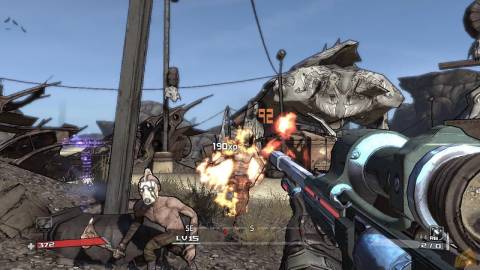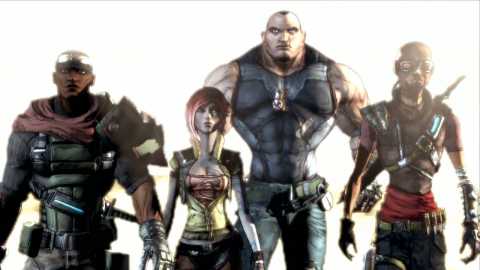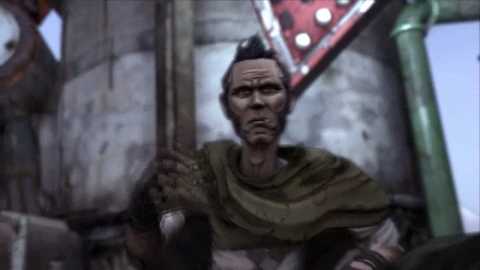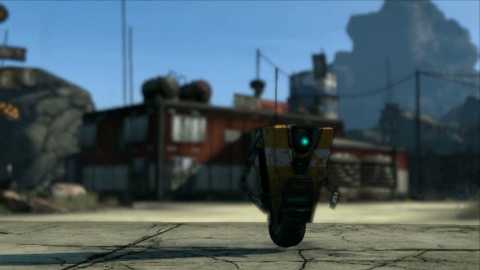
Borderlands is a loot-driven first-person shooter with a lot of different role-playing game hooks throughout. The game is structured a bit like an MMO, with the world broken out into different zones and a very handy quest log that feels like it fell out of World of Warcraft. There are plenty of critical story-related missions to complete, but there are also a lot of side-quests that send you across every zone, usually to kill or collect something. It's easy to see the influence of games like Diablo on Borderlands, as well, because the game is constantly dropping procedurally generated items for you to collect. This is how the game's box is able to claim that it has "bazillions" of guns.
Of course, "bazillions" is a pretty high (and pretty made-up) number, and you'll probably never see the exact same gun twice. But much of the variety in the guns come from slight statistical tweaks to how much damage they do, their rate of fire, their reload speed, whether or not they have a scope, and so on. But the weapons still break down into a handful of traditional classes, like combat rifle, sub-machine gun, sniper rifle, rocket launcher, pistol, revolver, and so on. And as you start finding better weapons and becoming proficient with them, it quickly feels like 95 percent of the guns you're finding are nothing more than vendor trash that only exists to be sold off for more money. Still, it's cool to see how the different fire rates for different weapons makes them feel. Finding a rocket launcher that automatically launches its full magazine of three rockets and quickly reloads, for example, is a real thrill, especially considering how sluggish most of the other launchers are. The thrill of never knowing when you're going to find a useful or rare weapon is very substantial, and it's more than enough to keep you coming back to wade through the endless avalanche of common junk.

The other big deciding factor in how you'll play Borderlands comes from the four character classes you'll choose from at the beginning of the game. Though there aren't any meaningful item restrictions that will prevent you from playing any class however you please, each class has its own skill tree that will build your character in a variety of different ways. You get one skill point per level once you hit level five, and stop getting them when you hit the level cap at level 50. The soldier class has skills that can make him something of a medic, such as cauterize, which lets you heal other players by shooting them. He also has skills that help him further specialize in the use of combat rifles and shotguns, but specializing in specific weapons doesn't seem like a great idea, since you never know what the next amazing gun you're going to find will be. I spent most of my time with a soldier and probably used a sub-machine gun for most of the game.
The other three classes feel like they want you to specialize your play style in a much more dramatic way than the soldier through a mix of weapon specialization skills and class-specific action skills. The Hunter has a bird that can be called out to attack enemies. Plenty of skill points can be spent making the bird more effective, and plenty more can be spent specializing in sniper rifles, which are only really useful in specific situations because most of the game's enemies are all about closing the gap and getting right up in your face. That doesn't leave a lot of room to snipe.
The siren has a "phasewalk" action skill that lets you avoid damage for a brief period of time. You also explode into and out of the phased state, which damages nearby enemies. Most of the siren's other abilities deal with either causing or preventing elemental damage, which comes in four forms: fire (good for burning flesh), shock (good for depleting shields), corrosive (good for armored targets), and explosive (good for... exploding).
The berserker class has skills that help him specialize in rocket launchers, which, like sniper rifles, aren't so hot in close quarters situations. His action skill is a berserk state that makes him a two-fisted brawler, which is a lot of fun to use, especially once you've spent some skill points to trick it out.

Completing the game also unlocks "playthrough 2," a sort of New Game Plus option that lets you take your existing character and start over in a world where the first enemies you encounter are around level 34 or so. It's certainly more difficult the second time around, but if you take the time to do more than just the critical story missions and complete a good chunk of side-quests, you'll be a few levels ahead of the opposition most of the time, giving you a distinct advantage. There is no playthrough 3, and there doesn't seem to be any way to replay quests that you've completed, either. This seems like it'd eventually lead to a situation where your character is unsuitable as a host for a multiplayer game, since the host determines which quests are active.
The enemies in Borderlands break down into around eight different types, including the wild, dog-like skags, sizable enemy crabs, humanoid bandits, spiderants, flying creatures, and so on. A lot of the enemy AI is very predictable, and just about anything that isn't a human will usually just rush in your direction and start doing as much damage as possible. Human enemies will occasionally take cover, but they still aren't very bright. That also applies to boss battles, as well. The game's two largest, coolest-looking boss fights can be summed up by the following strategy: "stand still and aim for the thing that looks like a lady's naughty bits." On my first playthrough, I beat the final boss without even moving. It's a shame that the enemy AI isn't more wily, but in most cases, they make up for their lack of smarts by outnumbering you by a wide margin. So you might want to bring some friends.
You can certainly play alone and solo your way through the entire game, but it's a lot more interesting if you engage in cooperative play. Borderlands lets up to four players band together, and the game's difficulty slides up as you add players, making everything a bit more exciting. A lot of the game feels like it was built for co-op play, from the two-man vehicles that let one guy sit on a turret to a dueling system that lets you fight one-on-one against another player to a full-on arena that lets all four players engage in round-based battles against one another. Players can revive their friends, too, which is added on top of a neat "second wind" feature that brings a downed player back to life if he can shoot and kill an enemy while he's bleeding out. The game also claims that you'll find more and better loot when you play with others.

Though there are a few too many spots in the game where the frame rate noticeably drops, Borderlands is a great-looking game. It's the art style that makes it stand out, with a lot of awesome texture work that makes the entire game look like it was drawn by hand. It makes the environments, most of which have the look of a post-apocalyptic wasteland, really catch your eye. Effects, such as the way enemies burn up when they die from a fire attack, are also really great to see... and hear. The game's got some terrific screams to go along with watching a man burn alive. Terrific screams.
The structure of Borderlands makes it feel like an MMO game that doesn't require you to rely on groups of other players to enjoy. Though it's probably better when you're playing online with friends, playing alone is still perfectly fine. It's also one of those games that's so strong in parts that its shortcomings become almost glaring by comparison. As such, the game's barebones story, lackluster AI, and insufficient player trading options are real disappointments that prevent the game from reaching its full potential. But when you're frantically trying to stay alive while getting swarmed by an angry horde of gigantic spiderants, chances are you won't care much about that other stuff. Borderlands strongly succeeds where plenty of other Diablo-inspired games have failed miserably.